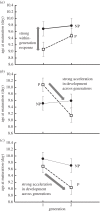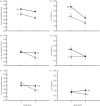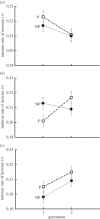Local adaptation in transgenerational responses to predators
- PMID: 26817775
- PMCID: PMC4795015
- DOI: 10.1098/rspb.2015.2271
Local adaptation in transgenerational responses to predators
Abstract
Environmental signals can induce phenotypic changes that span multiple generations. Along with phenotypic responses that occur during development (i.e. 'within-generation' plasticity), such 'transgenerational plasticity' (TGP) has been documented in a diverse array of taxa spanning many environmental perturbations. New theory predicts that temporal stability is a key driver of the evolution of TGP. We tested this prediction using natural populations of zooplankton from lakes in Connecticut that span a large gradient in the temporal dynamics of predator-induced mortality. We reared more than 120 clones of Daphnia ambigua from nine lakes for multiple generations in the presence/absence of predator cues. We found that temporal variation in mortality selects for within-generation plasticity while consistently strong (or weak) mortality selects for increased TGP. Such results provide us the first evidence for local adaptation in TGP and argue that divergent ecological conditions select for phenotypic responses within and across generations.
Keywords: ecological epigenetics; life-history evolution; maternal effects; phenotypic plasticity.
© 2016 The Author(s).
Figures




Similar articles
-
Predator-induced phenotypic plasticity within- and across-generations: a challenge for theory?Proc Biol Sci. 2015 Jan 7;282(1798):20142205. doi: 10.1098/rspb.2014.2205. Proc Biol Sci. 2015. PMID: 25392477 Free PMC article.
-
Contrasting gene expression programs correspond with predator-induced phenotypic plasticity within and across generations in Daphnia.Mol Ecol. 2017 Oct;26(19):5003-5015. doi: 10.1111/mec.14213. Epub 2017 Jul 10. Mol Ecol. 2017. PMID: 28628257
-
Interpopulation variation in a fish predator drives evolutionary divergence in prey in lakes.Proc Biol Sci. 2011 Sep 7;278(1718):2628-37. doi: 10.1098/rspb.2010.2634. Epub 2011 Jan 26. Proc Biol Sci. 2011. PMID: 21270045 Free PMC article.
-
Transgenerational plasticity and climate change experiments: Where do we go from here?Glob Chang Biol. 2018 Jan;24(1):13-34. doi: 10.1111/gcb.13903. Epub 2017 Oct 12. Glob Chang Biol. 2018. PMID: 29024256 Review.
-
Natural resilience in Arctic charr Salvelinus alpinus: life history, spatial and dietary alterations along gradients of interspecific interactions.J Fish Biol. 2014 Jul;85(1):81-118. doi: 10.1111/jfb.12321. Epub 2014 Apr 23. J Fish Biol. 2014. PMID: 24754706 Review.
Cited by
-
DNA methylation mediates genetic variation for adaptive transgenerational plasticity.Proc Biol Sci. 2016 Sep 14;283(1838):20160988. doi: 10.1098/rspb.2016.0988. Proc Biol Sci. 2016. PMID: 27629032 Free PMC article.
-
Effect of DNA methylation, modified by 5-azaC, on ecophysiological responses of a clonal plant to changing climate.Sci Rep. 2022 Oct 14;12(1):17262. doi: 10.1038/s41598-022-22125-z. Sci Rep. 2022. PMID: 36241768 Free PMC article.
-
Transgenerational Plasticity Enhances the Tolerance of Duckweed (Lemna minor) to Stress from Exudates of Microcystis aeruginosa.Int J Mol Sci. 2024 Dec 4;25(23):13027. doi: 10.3390/ijms252313027. Int J Mol Sci. 2024. PMID: 39684737 Free PMC article.
-
Environmental variation mediates the evolution of anticipatory parental effects.Evol Lett. 2020 Jun 10;4(4):371-381. doi: 10.1002/evl3.177. eCollection 2020 Aug. Evol Lett. 2020. PMID: 32774885 Free PMC article.
-
Transgenerational plasticity in the eye size of Daphnia.Biol Lett. 2021 Jun;17(6):20210143. doi: 10.1098/rsbl.2021.0143. Epub 2021 Jun 16. Biol Lett. 2021. PMID: 34129799 Free PMC article.
References
-
- Fox CW, Mousseau TA. 1998. Maternal effects as adaptations for transgenerational phenotypic plasticity in insects. In Maternal effects as adaptations (eds Mousseau TA, Fox CW), pp. 159–177. New York, NY: Oxford University Press.
MeSH terms
Associated data
LinkOut - more resources
Full Text Sources
Other Literature Sources

